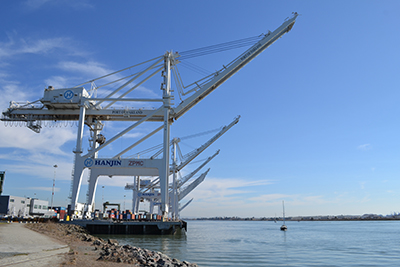Port of Oakland may get second-fewest ship visits in a decade
"A good trend," say port officials, who note that there's more cargo, fewer diesel emissions, and less berth crowding

New data indicates the Port of Oakland this year may receive its second-fewest container ship visits in a decade. A Port executive called it "a positive sign."
“This is a good trend,” said Maritime Director John Driscoll. “Our cargo volume is up but with fewer ships, we reduce diesel emissions and ease berth crowding.”
The port said that through July, 954 container ships have visited Oakland in 2017. That’s down 7.6 percent from 1,032 visits at the same time last year. If the trend persists, vessel calls for the full year would total about 1,650. That would be about 100 fewer ships than Oakland received last year.
The port said 100 fewer ship calls should result in reduced diesel particulate emissions in Oakland. It should also ease demand for berthing space at the port’s marine terminals. With less vessel traffic, there’s little need for ships to idle in San Francisco Bay waiting for berths.
Vessel calls in Oakland have declined 15 percent since 2007, the Port said. The low point was 2015 when 1,433 ships visited.
Despite fewer vessel calls, the port said loaded container volume is up 2 percent in 2017. If that pace holds, Oakland could set a cargo record for the second straight year.
The port said the phenomenon of more cargo but fewer ships reflects an industry-wide trend. Shipping lines are consolidating container volumes to cut costs, the port explained. With fewer voyages, they reduce fuel and other operating expenses.
Ships calling Oakland in 2017 are newer and larger, the Port said. It added that modern vessels are more fuel efficient, making them environmentally friendly.
One byproduct of larger ships: they’re loading and unloading about 11 percent more containers per visit, the port said. That challenges marine terminals and harbor truckers attempting to quickly deliver customers’ cargo. It was pointed out, however, that terminals have overcome the challenge through longer hours of operation and trucker appointments.
Dan Smith, Principal with the Tioga Group, told LM in an interview that capacity has grown faster than trade, so growth alone will not get the carriers the economies of scale they are seeking.
"All port would probably agree that handling the same or growing cargo volumes in fewer vessel visits can yield efficiencies at the berth," he said. "That does mean that you need the berth length to handle the larger ships...but Oakland definitely has that."

Article Topics
News & Resources
Latest in Materials Handling
The (Not So) Secret Weapons: How Key Cabinets and Asset Management Lockers Are Changing Supply Chain Operations MODEX C-Suite Interview with Harold Vanasse: The perfect blend of automation and sustainability Consultant and industry leader John M. Hill passes on at age 86 Registration open for Pack Expo International 2024 Walmart chooses Swisslog AS/RS and software for third milk processing facility NetLogistik partners with Vuzix subsidiary Moviynt to offer mobility solutions for warehouses Materials Handling Robotics: The new world of heterogeneous robotic integration More Materials HandlingAbout the Author
Subscribe to Materials Handling Magazine

Find out what the world's most innovative companies are doing to improve productivity in their plants and distribution centers.
Start your FREE subscription today.
April 2024 Modern Materials Handling

Latest Resources










